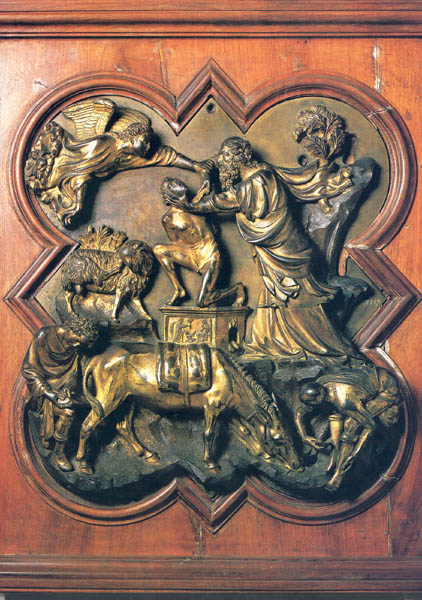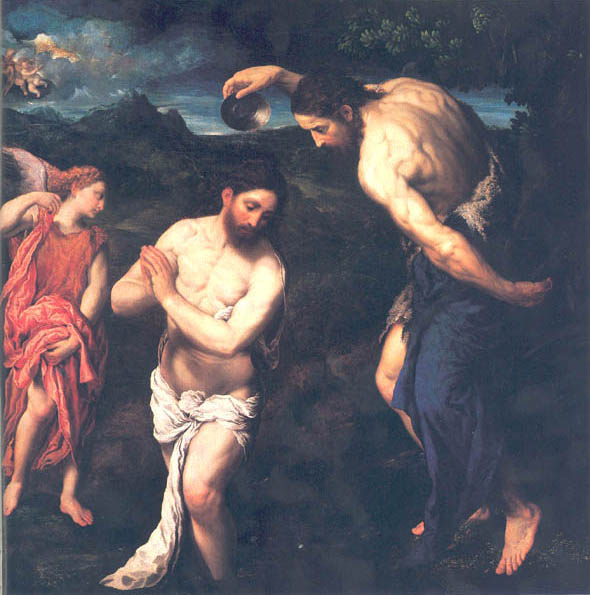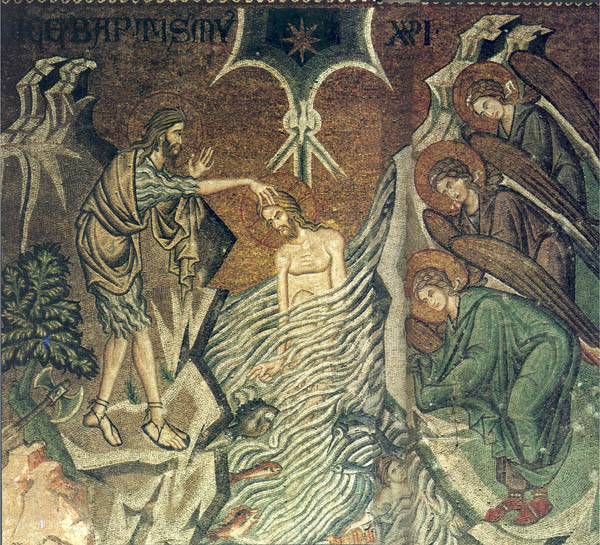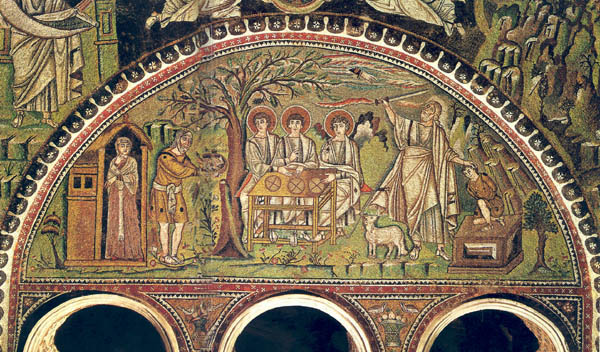
John’s baptism of Jesus appears in all three synoptic Gospels (Matthew, Mark and Luke). Here is how Mark describes it in a mere 53 words in Greek:
“In those days Jesus came from Nazareth of Galilee and was baptized by John in the Jordan. And when he came up out of the water, immediately he saw the heavens opened and the Spirit descending upon him like a dove; and a voice came from heaven, ‘Thou art my beloved Son; with thee I am well pleased’” (Mark 1:9–11; see also Matthew 3:13–17; Luke 3:21–22).
Exegetes have puzzled for centuries over the theological meaning of Jesus’ baptism, particularly as derived from Mark’s account. A new understanding emerges, I believe, when we realize that this baptism story was modeled on the Old Testament account of Abraham’s near-sacrifice of his son Isaac, an episode known to students of the Old Testament as the binding of Isaac.
In the biblical form of the story (Genesis 22), God tests Abraham by telling him to take his only son Isaac and offer him to God as a sacrifice. Abraham takes his son to the mountain to which God directs them and prepares an altar on which he lays wood. Abraham then binds his son, lays him on the altar and raises his knife to slay him. At this dramatic moment an “angel of the Lord called to him from heaven” and tells Abraham to desist, “for now I know that you fear God, seeing you have not withheld your son, your only son, from me.” Abraham “lifted up his eyes” and sees a ram caught in a thicket. Abraham then sacrifices the ram in place of his son Isaac.

At first glance, the stories of Jesus’ baptisma and the binding of Isaac appear to have little relationship to one another. Let us look more closely, however.
The story of the binding of Isaac that I have just recounted is the story as it is told in Genesis 22. But it was such a powerful story that it was told and retold over the centuries in various versions from a variety of viewpoints and with a variety of embellishments. Indeed, this was true of much of the Old Testament. That is how the Midrash developed. The Midrash is a collection of retellings and elaborations of biblical stories written down beginning in about 400 A.D. Many of the exegetical traditions that the Midrash embodies, however, were known much earlier.
Over the centuries Jewish exegesis and elaboration of Scripture occurred in many forms in addition to the Midrash—forms we might call midrashic. One example is the Targums. The Targums are loose translations of the Hebrew scriptures—paraphrases might be a better word—into Aramaic, at a time when Aramaic was the everyday language of the people. The Targums often contain embellishments to and explanations of the Hebrew scriptural text not found in the original.
One of the most significant changes introduced into the biblical account by later midrashic versions (including the Targums) concerns the role of Isaac, who plays an increasingly prominent part. As one scholar has described the difference:1
“In Genesis it is Abraham’s faith and obedience to God’s will even to the offering of his only son, the child of promise, that constitutes the whole significance of the story: Isaac is a purely passive figure. In the rabbinical literature, however, the voluntariness of the sacrifice on Isaac’s part is strongly emphasized.”
In the account in Genesis, the main character is Abraham; Isaac seems to be a mere lad. According to one Midrash, however, he was 37 years old.
The Targums survive, in part, in several manuscripts, known to scholars as Targum Pseudo-Jonathan (also called Yerushalmi I), Neofiti, and the Fragmentary Targum (or Yerushalmi 2). Variations occur among the manuscripts, but the basic emphasis on Isaac’s willingness to be sacrificed is common to all of these Targumic manuscripts.
It is the Targumic versions of the story of the binding of Isaac that I believe served as a model for the story of the baptism of Jesus. Thus, a version of the Isaac story, now found in these Targums, must have been widely known when the story that lies behind the Gospel account of Jesus’ baptism was composed.b
When Jesus came out of the water after his baptism, the following things occurred (again I quote from Mark):
1. “He saw the heavens opened and the Spirit descend[ing] upon him.”
2. “A voice came from heaven [and said], ‘Thou art my beloved Son; with thee I am well pleased.’”
Each of these features of the baptism story finds its parallel in the Targumic stories of the binding of Isaac.
1. As Isaac lay bound upon the altar, he too looked up and saw “the angels of the height.”2 He too had a vision and saw “the Shekinah [the divine essence or spirit] of the Lord.”3
2. A voice from heaven explains the significance of the scene: “Come, see two chosen individuals in the world; the one sacrificing and the other being sacrificed; the one sacrificing is not hesitating and the one being sacrificed stretches forth his neck.”4
Bible scholars would say that the two stories exemplify the same form, a form often used by biblical writers to describe a vision. When a vision is described, the narrative frequently mentions the opening of heaven or a voice from heaven. In the Targums, this literary form of the vision is retained, but greater stress is placed on the content of the heavenly words than is the case in the biblical visions. The heavenly words emphasize the significance of the moment for the life of the person who receives the vision.
In both the baptism story and the binding story, however, the voice from heaven describes the significance of the scene, in one instance for Jesus, and in the other for Isaac. Both accounts exemplify the same literary form, namely the Old Testament form of a vision providing interpretive words from heaven.5

The fact that both stories exemplify the same literary form is only the beginning; they have far more in common than literary form. Within this form we find additional striking similarities.
Lying on the altar, Isaac looks up and sees “the angels of the height.” This seems to be another way of saying that the heavens were opened, since in the ancient world view God and his angels were to be found above the vault of the heavens. In the Gospel account, the heavens had to be “opened”c before the Holy Spirit could be seen.
More significant, the content of the vision is almost the same in both stories. In the Gospels, Jesus sees “the Spirit descending”; in the Targumic accounts of the Genesis story, “the Shekinah of the Lord” is revealed to Issac.
The similarity between the “Spirit”d and the “Shekinah” is obvious. The Shekinah, in rabbinic thought, is a “manifestation” of God himself, reflecting “his nearness” to his people.6 In the Gospel accounts, the Spirit or Holy Spirit indicates the presence and nearness of God.
So close are the two terms—Shekinah and Holy Spirit—that in some texts they are used interchangeably. As one observer has commented:7
“The two expressions are often interchanged in the old Rabbinic texts. Both are frequently used as synonyms for God…. The man who is closely united with the Shekhinah also possesses the Holy Spirit, and the one possessing the Spirit also sees the Shekhinah.”
Moreover, the words the heavenly voice addresses to Jesus have a direct relationship to the account of the binding of Isaac.
Says the heavenly voice: “Thou art my beloved Son; with thee I am well pleased.”
In the Greek translation of the Bible known as the Septuagint, translated from the Hebrew about 300 B.C., Isaac is referred to as “the beloved son.” Thus the heavenly voice echoes the Greek translation of Genesis.e
The second half of the message from the heavenly voice, “with thee I am well pleased,” also finds an echo in the binding of Isaac. In effect, the heavenly voice tells Jesus that he is the recipient of God’s “elective good pleasure.”8 The Greek word for “pleased” is

Another connection that has frequently been made between the two stories is that Isaac was a near-sacrifice, while Jesus, the lamb of God, was actually sacrificed.g In the Targums to Leviticus 22:27, Isaac is referred to as a “lamb who has been elected/chosen.”
Thus, the concept of God’s choice or election is found both in the story of Jesus’ baptism and in the binding of Isaac.h
One of the most enigmatic details in the baptism story is the dove: “The Spirit descend[ed] upon [Jesus] like a dove.”
Most commentators see the dove as a symble of Israel. A beautiful Midrash comments on the phrase from the Song of Songs 4:1, i “Thine eyes are as doves”:9
As the dove is chaste, so Israel are (sic) chaste. As the dove puts forth her neck for slaughter, so do (sic) Israel, as it says, ‘For Thy sake we are killed all the day’ [psalm 44:23). As the dove atones for iniquities, so Israel atone (sic) for the other nations.”
The dove shares a remarkable characteristic with Isaac: both the dove and Isaac stretch forth their necks as sacrifices. As the Targums say: “Come, see two unique individuals [Abraham and Isaac] … the one being sacrificed [Isaac] stretches forth his neck.” Note the equation. The dove, a symbol for Israel, makes atonement and stretches forth the neck. Isaac, too, stretches forth his neck on the altar as he makes atonement for Israel. Could the dove, associated with Isaac in later rabbinic literature, have been already associated with him in New Testament times? Could the dove in the baptism story have been a reminder of the similar roles played by Isaac and Jesus? Here is another bridge between the figure of Isaac and the story of Jesus’ baptism.

In short, the baptism story was told with the story of the binding of Isaac in mind, as suggested not only by the literary form the stories share, but also by direct similarities and echoes in content. The reader of the baptism story was supposed to recall the story of Isaac.
Telltale verbal similarities between Mark and the Septuagint translation of Genesis 22 also support this interpretation (a fact no other commentator seems to have noticed). Both stories begin with the same introductory phrase: “and it happened.” (The Revised Standard Version omits this phrase in translating Mark 1:9.)
Again: Jesus “saw” the heavens “being split,” while Abraham “saw” the place where he was to sacrifice Isaac. In Genesis 22:14, Abraham names the place “(The) Lord will see.”
And while Jesus saw the heavens “being split,” Abraham “split” the wood for the burnt offering.
In Genesis 22:11 and 22:15, the voice calls to Abraham “from heaven” (singular); in Mark 1:11 a voice comes “from heaven” (plural).
The cumulative effect of the verbal agreements within the short span of the baptism narrative is indeed remarkable.
The author modeled his story of the baptism of Jesus on the story of the binding of Isaac for a reason. He had a point to make, a theological point.
The theology of the Targumic story of the binding of Isaac is plain. The sins of Israel were forgiven by the continual sacrifices offered in the Temple at Jerusalem. The near-sacrifice of Isaac was regarded as a kind of original sacrificial offering that validated and gave significance to all subsequent sacrifices offered on the same mountain.
The Targum is clear that Mt. Moriah, where the binding of Isaac occurred, was in fact the Temple Mount. The relationship between the near-sacrifice of Isaac and the regular sacrifices offered on the Temple Mount is reflected in Geza Vermés’s beautiful translation of the Fragmentary Targum to Genesis 22:14:10
“Now I pray for mercy before you, O Lord God, that when the children of Isaac come to a time of distress, you may remember on their behalf the binding of Isaac their father, and loose and forgive them their sins and deliver them from all distress, so that the generations which follow him may say: In the mountain of the Temple of the Lord, Abraham offered Isaac his son….”
The theological significance of the baptism story is not directly stated; hence, the confusion among contemporary interpreters. The theological significance is not directly stated, however, because the original hearers would have made the association with the Isaac story. Jesus is like Isaac, except that he was in fact sacrificed. They would have understood that the theology of the baptism story was the theology of the cross. Just as Isaac was offered as an expiatory sacrifice, so Jesus would be offered.
The theological point of the Isaac story dovetails with the theology of the cross. If the suggestion I am making is correct, the shadow of the sacrifice on the cross falls across the baptism story, which introduces the adult Jesus to the Gospel reader.
This suggestion is reinforced by the fact that two important words tie the baptism to the cross. The first is the word baptism itself.
In the third prediction of his suffering and death, Jesus, on the road to Jerusalem with his 12 disciples, foretells what will happen to him (Mark 10:32–34). James and John ask to sit at his right and left hand in his glory Jesus replies:
“You do not know what you are asking. Are you able to drink the cup that I drink, or to be baptized with the baptism with which I am baptized?” (Mark 10:38)
A second connection between Jesus’ sacrifice on the cross and his baptism may be found in an occurrence described in a single word. As Jesus breathed his last on the cross, the curtain of the Temple was torn in two (Mark 15:37–38; Matthew 27:50–51). A more literal translation is “split” rather than “torn”; the Greek word is
Jesus’ baptism is thus connected both to his sacrificial death and to the story of the sacrificial binding of Isaac, on which the baptism story was modeled.
I do not mean to imply that this is the only correct interpretation of Jesus baptism, but it is surely one valid interpretation. There probably is no single correct interpretation of the baptism story. There are probably layers of meaning in the story. The baptism story was doubtless formulated in the early Aramaic-speaking church. It is entirely consistent with the rabbinic Palestinian milieu that there should have been more than one proper interpretation of a story. What I have presented is simply what the rabbis would refer to as “another interpretation.”
MLA Citation
Footnotes
In Matthew and Luke, the account of Jesus’ baptism follows directly after the account of his birth and infancy and is, in effect, introduced by the birth and infancy narratives. Mark does not contain a birth and infancy section; the story of Jesus’ baptism in Mark therefore serves a somewhat different function and plays a somewhat different role.
There is considerable scholarly debate about the date of the Targums. Although they may have been edited and “published” considerably later than New Testament times (some say as late as the seventh or eighth century A.D.), various passages in the Targums obviously must be dated much earlier. This is true of the material relating to the binding of Isaac. We have a number of clues suggesting that the Targumic version of the story of the binding of Isaac was well-known in New Testament times. For example, the works of Philo and Josephus and other first-century documents all describe the voluntary nature of Isaac’s submission to sacrifice. Even more significant is the fact that the Targumic material locates the binding of Isaac on the Temple Mount in Jerusalem. In the Targumic accounts, when Isaac looks up from the altar, he has a vision of God’s glory known in rabbinic literature as the Shekinah, who dwelt in the Temple. In this way the Targums use the binding of Isaac to prove the sole legitimacy of Jerusalem and its Temple as the place of sacrifice. This makes good sense only in the period before 70 A.D., before the Roman destruction of the Temple, and suggests that those details were incorporated into the story before the Temple’s destruction.
The Revised Standard Version says the “heavens opened”; a more accurate translation is that the heavens “split.”
In the parallel synoptic accounts, where Mark uses “Spirit,” Luke uses “Holy Spirit” (Luke 3:22) and Matthew uses “Spirit of God” (Matthew 3:16).
Some commentators suggest that the phrase “Thou art my beloved Son” is a quotation from Psalm 2:7, applied to Jesus by the heavenly voice. But the Psalm says, referring to Israel’s king, “You are my son,” not “my beloved son.” The absence of “beloved” is a serious objection to this view.
Some commentators argue that the Gospel phrase “with thee I am well pleased” is a quotation from Isaiah 42:1. Again, however, the verb in Isaiah is different: “Behold my servant … in whom my soul delights.”
See 1 Corinthians 5:7: “For Christ, our paschal lamb, has been sacrificed.” In John 1:29 Jesus is referred to as the “lamb of God.”
Unlike theories that attribute different parts of the heavenly voice in the baptism story to different parts of the Old Testament, the theory suggested here has the advantage of simplicity. Both parts of the statement are derived from the same story, the binding of Isaac.
Some Bibles, such as the popular Revised Standard Version, refer to the Song of Songs as the Song of Solomon, its traditional title, based on its customary attribution to Solomon. See Jack M. Sasson, “Unlocking the Poetry of Love in the Song of Songs,” BR 01:01.
For our purposes it does not matter whether the tearing of the curtain is a sign of God’s judgment on the Temple or whether it is a sign that access to God is now open and visible as a result of the cross.
This is a device known as gazera shava, which is an “analogy of expressions; that is, an analogy based on identical or similar words occurring in two different passages of Scripture.” (M. Mielzinger, Introduction to the Talmud [New York: Bloch, 1968], p. 143). According to exegetical practice, if one of the passages in which the word occurs is obscure, its meaning is to be ascertained from the other passage.
Endnotes
G. F. Moore, Judaism in the First Centuries of the Christian Era, Vol. 1 (Cambridge: Harvard University Press, 1932), p. 539.
Targum Pseudo-Jonathan to Genesis 22:14. The other two Targums, namely Neofiti and the Fragmentary Targum, use “the glory of the Shekinah of the Lord.” There is little difference between these two expressions.
Here I am especially indebted to the analysis of F. Lentzen-Deis, Die Taufe Jesu nach den Synoptikern (Frankfurt am Main: Knecht, 1970), pp. 97–248.
E. E. Urbach, The Sages—Their Concepts and Beliefs, translated from the Hebrew by I. Abrahams (Jerusalem: Magnes, 1975), p 43. Also see the discussion by A. Unterman, Encyclopedia Judiaca, Vol. 14, “Shekhinah” (Jerusalem: Keter, 1971), pp. 1350ff.
A. Marmorstein, “The Holy Spirit in Rabbinic Legend,” Studies in Jewish Theology, ed., J. Rabinowitz and M. Lew (Freeport, New York: Books for Libraries, 1972), p. 131.
G. Schrenk, Theological Dictionary of the New Testament, ed., G. Kittel, Vol. 2 (Grand Rapids, Michigan: Eerdmans, 1974), pp 740ff.

